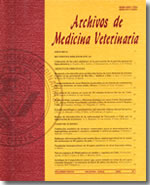Computed tomographic anatomy of the larynx in mesaticephalic dogs
Main Article Content
Abstract
The aim of this work was to describe the normal anatomy of the larynx and its adjacent structures in mesaticephalic dogs by computed tomographic (CT) images and correlate those with anatomical sections. For that, 2 clinically normal young-adult mesaticephalic dogs with body weight of 12.8 kg and 18.5 kg, respectively were used. Computed tomography of the larynx was performed in 2 dogs under general anesthesia and in dorsal recumbency. Transverse images of the larynx with a slice thickness of 3 mm and a gap of 2 mm interval were obtained using a soft tissue window. CT images were correlated with anatomical cross-sections views. The central cavity of the larynx that includes the laryngeal vestibule, glottis and infraglottic cavities were observed as hypodense areas in all CT images. Other spaces also identified included the piriform recess, the epiglottic vallecula and the laryngeal ventricles. The thyroid and the cricoid cartilages were clearly represented as linear hyperdense structures. The arytenoid cartilages were only minimally calcified due to the young age of the animals therefore poorly seen on CT. The epiglottis was identified as a transverse concave isodense structure. Results indicated that CT provides an excellent method for imaging evaluation of the complex anatomy of the larynx in dogs.

